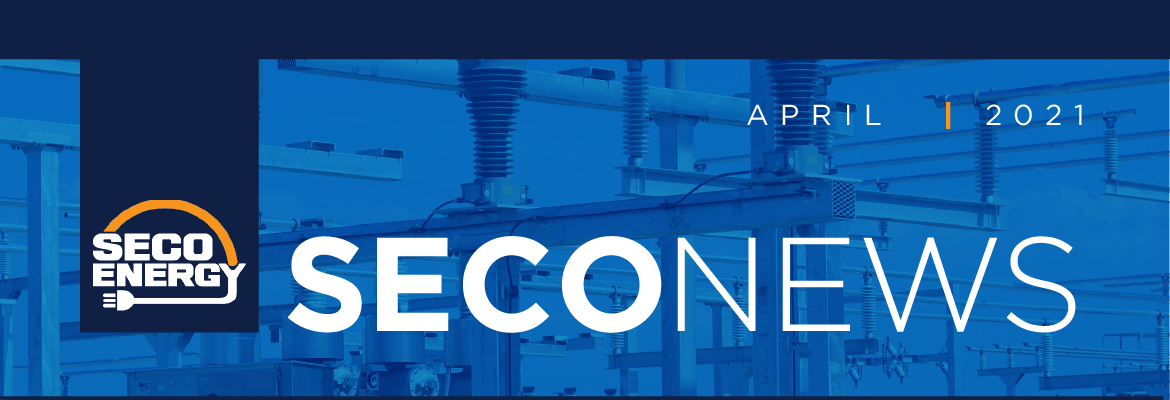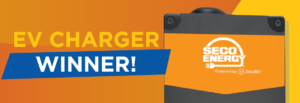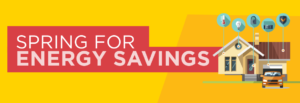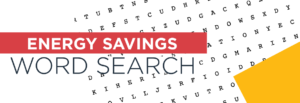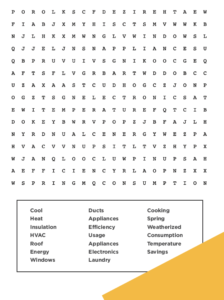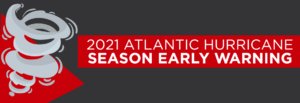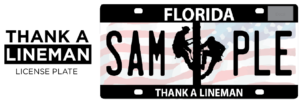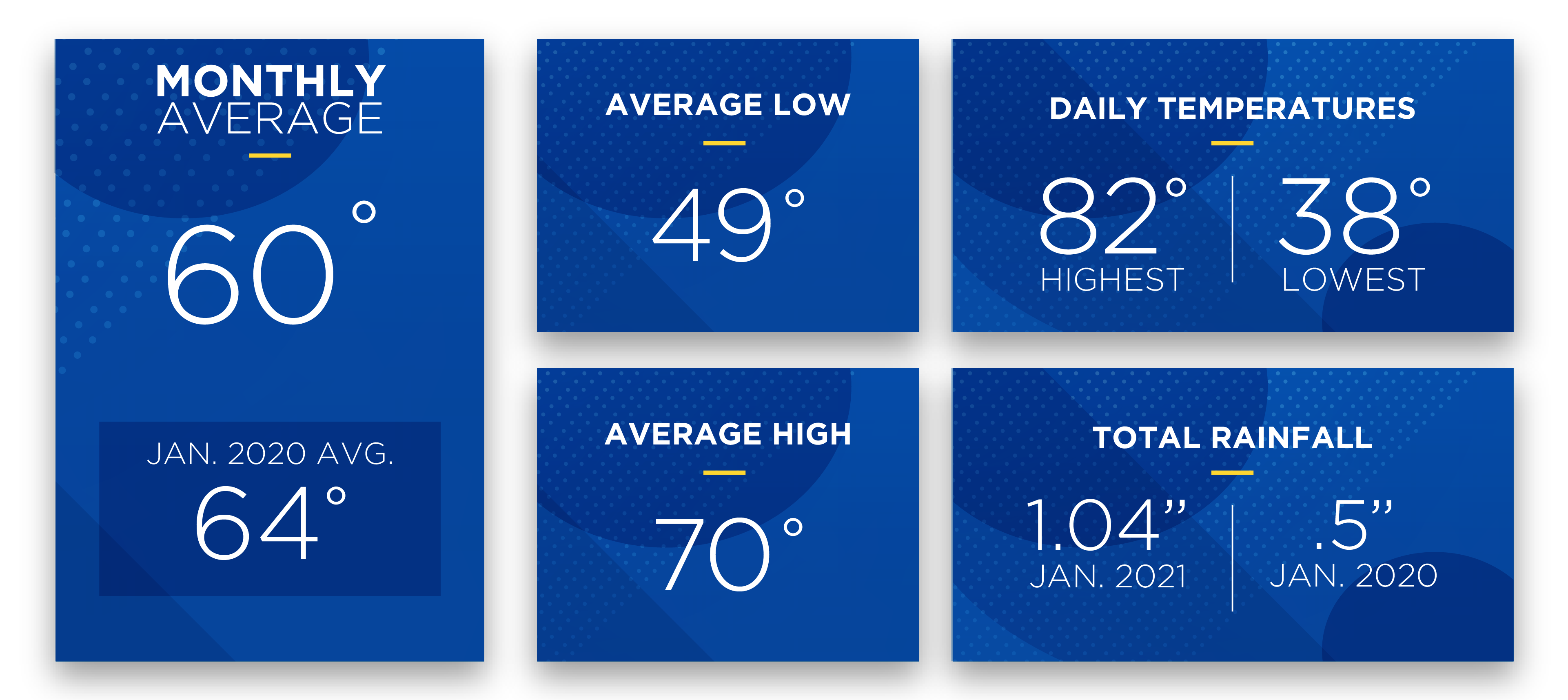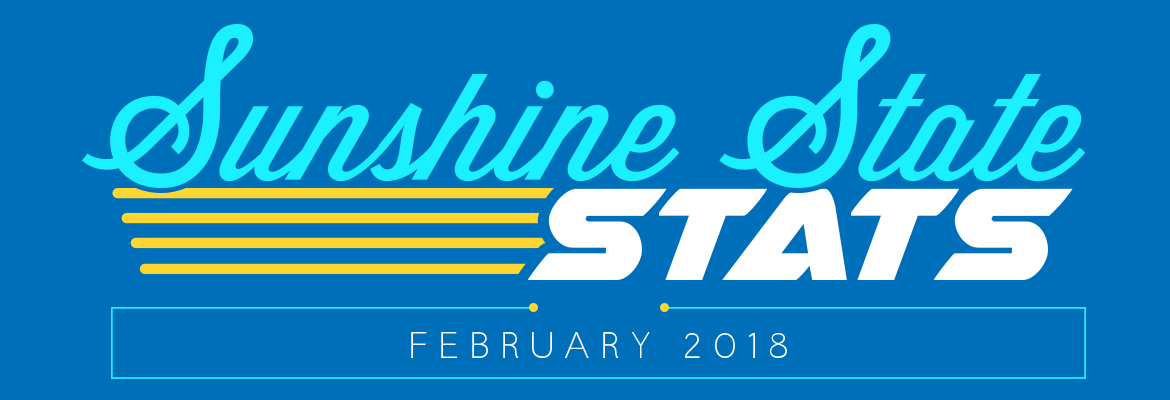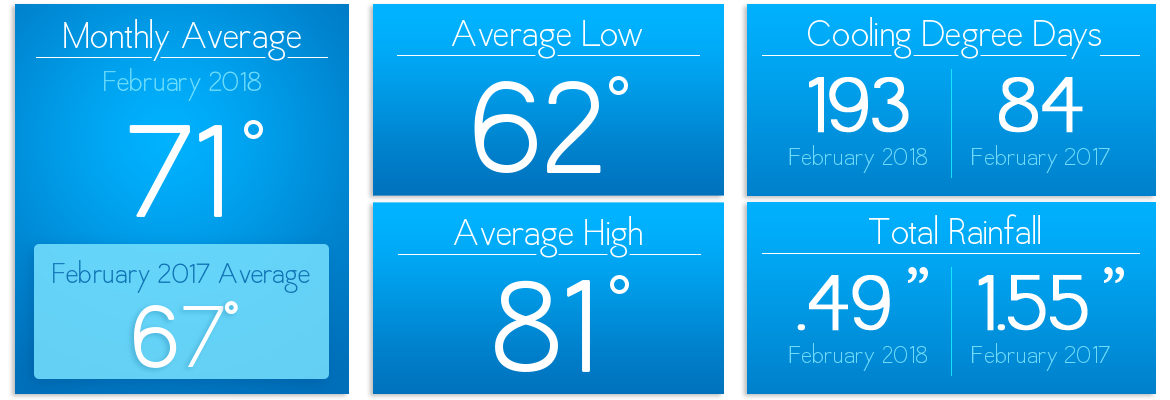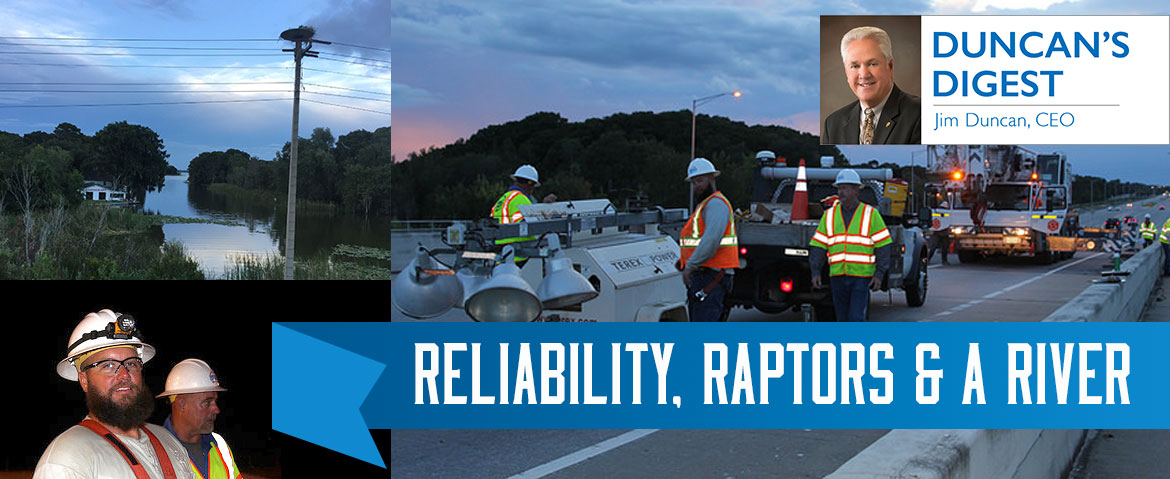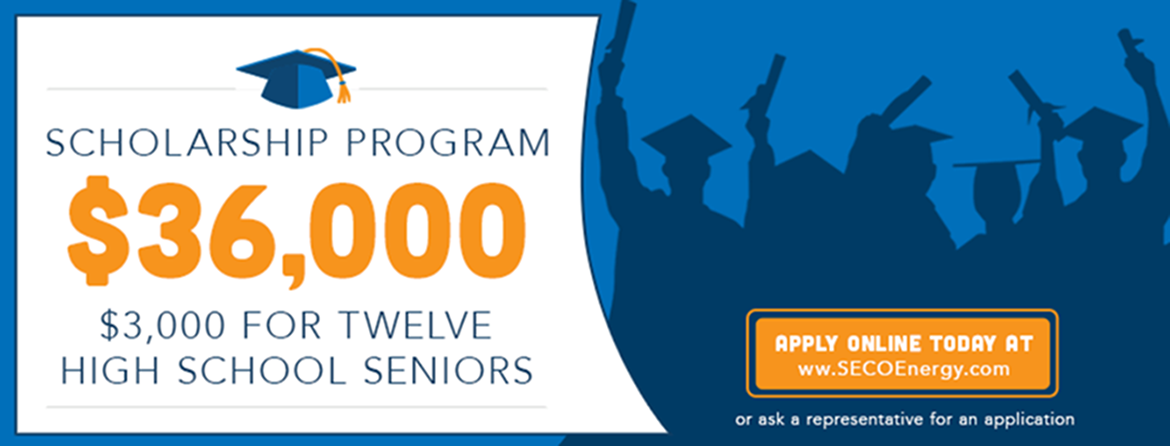SECO News, April 2021
Duncan’s Digest – Inverness Substation Upgrade
SECO Energy’s service territory covers 2,100 square miles, which is about the size of Delaware. At year-end 2020, we were serving 216,477 homes and businesses in seven Central Florida counties. The bulk of our members live in Citrus, Lake, Marion and Sumter Counties, with smaller numbers of members in Hernando, Levy and Pasco Counties.
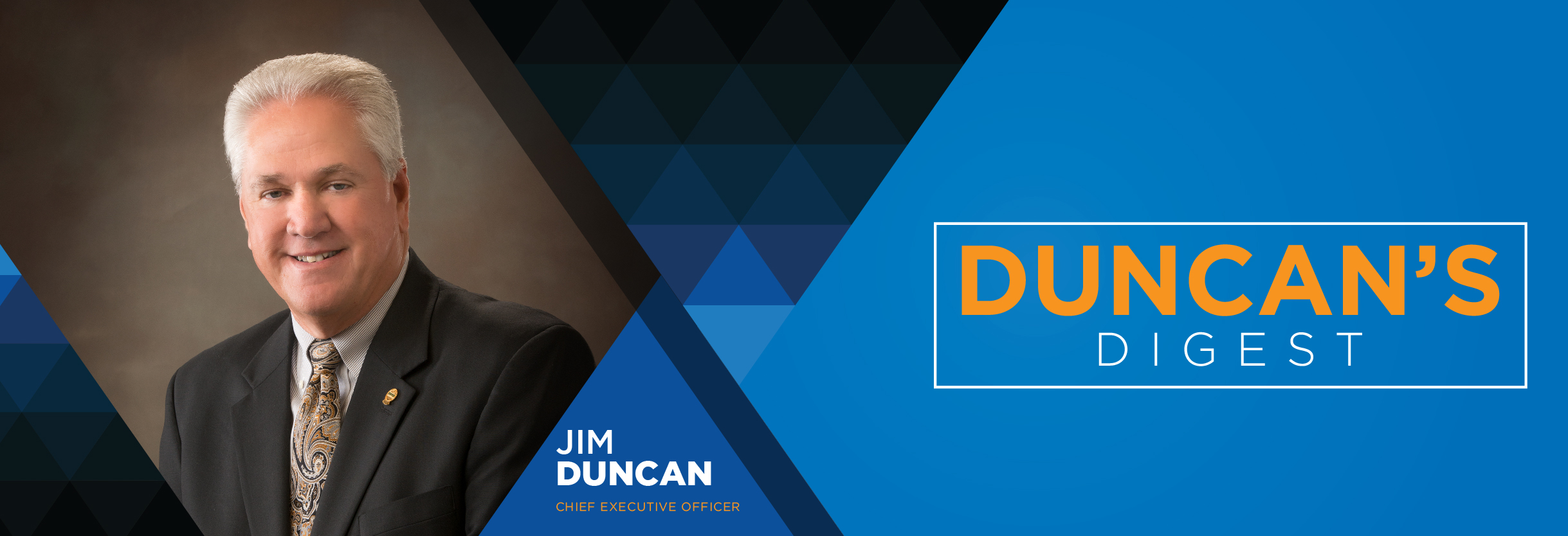
Our cooperative purpose is to provide exceptional service to our members, co-workers and communities. That exceptional service is reflected in SECO Energy winning coveted J.D. Power awards in 2015, 2016 and 2017 when our satisfaction scores topped all utilities in the nation. In 2020, we upheld our position as an American Customer Satisfaction Index (ACSI) frontrunner in Florida and nationally with a score of 91.
We definitely have a strong reputation to uphold. Another example of our exceptional service is a meticulous inspection and maintenance schedule that ensures day-to-day reliability while expanding an electric system that meets both current and future members’ energy needs.
In the July 2020 SECO News edition, I communicated about the Marion Oaks substation rebuild underway in Marion County. That project, including the demolition of the older adjacent substation, is almost complete.
A new project in the works is the Inverness substation rebuild in Citrus County. The Inverness substation was reconstructed in 1982. Due to its age, the substation needed a complete rebuild. This substation serves just under 6,000 members. The rebuild includes a high-side ring bus and steel structures that support the heavy, high voltage transmission line. The high-side ring bus will increase service reliability for all members served by the Inverness sub by creating redundancy through looped service.
The Inverness substation rebuild also improves reliability for members served by the nearby Floral City substation as well. Both substations are looped in with two separate Duke Energy transmission lines. Currently, members served by both substations experience an outage if even one of the Duke transmission lines experiences a fault or operates. When the new ring bus is in place at the Inverness substation, members served by our Floral City sub will no longer experience an outage if the fault occurs between the transmission line and the Inverness substation.
Along with the ring bus on the high side, we’re working to re-gasket the existing power transformer, install a new metering package and implement a state-of-the-art relay schematic. The new foundation is in place, the fence surrounding the substation has been installed, and a new control house is being constructed on-site. The Inverness substation rebuild is on schedule for completion in early summer, just in time for storm season to arrive.
The total value of our electric facilities systemwide is inching closer to the $1 billion mark. At year-end 2020, the value of SECO’s utility plant was $955.9 million. We’re spending about $3.2 million per month to improve existing members’ service reliability and to build new infrastructure to meet the growing demand in our area.
Without question, your electric service is supported by an extensive, robust and well-maintained infrastructure.
Sincerely,
Jim Duncan
Chief Executive Officer
Advice from The Old Farmer’s Almanac
The Old Farmer’s Almanac recommends the best days in April and May to complete indoor and outdoor projects. Ready for spring cleaning? Wash windows on April 10 and 11 and May 7 – 9, and wash floors on April 8 and 9 or May 5 and 6. The best days to bake are on April 18 and 19 and May 15 and 16. If spring yard work is on your list, the best days prune to encourage growth are April 20 and 21 and May 17 – 19. Prune to discourage growth on April 1, 2, and 10 and May 7 – 9.
Call 811 Before You Dig
Longer days and sunny weather make spring the perfect time to tackle your honey-do list. April is Safe Digging Month and Florida law requires you to call 811 or visit www.call811.com online before you dig.
811 is a free service that will locate and mark underground utilities on your property or in the area you plan to dig. Never install a fence, plant a garden, add new landscaping or trees before contacting 811. Are you working with a contractor on a project? Make sure your contractor has connected with 811 before beginning the project on your property.
Wait for the flags! Keep shovels out of the ground until the 811 locating service has responded to your request and flagged the approximate area where underground utility lines (electric, water, gas, communications, etc.) are located.
Know what’s below – call 811 before you dig. In Florida – it’s the law.
EV Charger Winner
Pamela Gladd from Minneola is the March winner of a SECO Energy branded JuiceBox Pro 40 EV Level 2 charger. We’re giving one charger away each month while supplies last. To enter, text “EV” to (352) 320-4500 for a link to enter. Or click on the EV Charger Giveaway homepage banner.
Learn more about the benefits of electric vehicle ownership on our EV website pages. You’ll find an EV savings calculator, information about CO2 reduction, an EV and PHEV model finder and a nationwide charger-finder map. Visit our Electric Vehicles website section for more details.
Watch SECO News for next month’s charger winner.
Spring for Energy Savings
The Department of Energy (DOE) at energy.gov estimates the energy used to cool and heat your Central Florida home is 35 to 40% of your total energy consumption. You control how and when you use electricity. The condition and age of your home’s HVAC system, insulation, roof, windows, ducts, appliances and lifestyle also affect your energy consumption. Newer, well-insulated, properly weatherized homes with double-pane windows and ENERGY STAR-rated appliances consume less energy.
The number of people living in your home and weather also affect energy consumption. More people living in the house create more laundry, heating, cooling, cooking and increased hot water and electronics use. Central Florida is known for scorching summer temperatures that cause your HVAC to work overtime to keep the home cool. During a cold snap, the heating system also runs more frequently to warm the house.
Want help to reduce your energy consumption and lower your monthly energy bill? SECO Energy’s online energy-efficiency tools can help you spring for energy savings with low-cost and no-cost tips and ideas to help you reduce your energy use.
Home Energy Assessment
Our Home Energy Assessment is an online energy audit that you can complete from the comfort of your home. Fill out the assessment based on your home and lifestyle. Submit your answers and email address, and in just minutes you’ll receive energy-savings advice tailored to your home and lifestyle. Complete the energy-saving ideas, and you’ll be on your way to consuming less energy – and saving money.
Energy Estimator
Are you interested in seeing the math associated with your energy usage? Visit our Energy Estimator online to calculate the estimated costs for each of your home’s appliances and electronics. Submit your email address to receive no-cost and low-cost energy-savings suggestions via email.
Energy Savings Word Search
After completing our Home Energy Assessment and Energy Estimator, sharpen your energy-saving knowledge with this month’s Energy Savings word search.
2021 Atlantic Hurricane Season Early Warning
Traditionally, the Atlantic hurricane season begins on June 1. But the past six hurricane seasons have seen hurricanes and tropical storms form in mid-May. Because of this change, the National Hurricane Center (NHC) will begin its Atlantic Tropical Weather Outlook earlier on May 15 instead of waiting until June 1.
What does this mean for SECO Energy members? SECO is StormReady, and we encourage you to begin your preparations for hurricane season now. Don’t wait until a hurricane or tropical storm is heading our way to prepare.
Learn more about hurricanes and tropical storms in our Hurricane Handbook. You’ll find helpful information on emergency supplies for people and pets. We’ve also included tips for before, during and after a storm. Pick up a copy of our Hurricane Handbook at one of our five Member Service Centers or visit our Storm Preparation page.
Winners’ Circle
Have you engaged with our virtual assistant Electra who can answer thousands of calls without missing a beat? Ask Electra for assistance instead of waiting to speak with a representative. Each week, we’ll draw one winner who will receive a $25 gift card. Winners are drawn from all members who called and successfully took care of business with Electra.
February’s Winners Are:
Mark Fagan from Clermont
Lynn Pulchano from Inverness
Don Whittigton from Dunnellon
Sandra Ennulat-Davis from Eustis
Congratulations to our three March winners in our Go Green and Win: Paperless Billing and Bank Draft incentive.
Narasimha Murthy from Tavares is the winner of a $200 SECO Energy bill credit.
Karen Chapman from Ocala is the winner of a NEST thermostat.
John Johnson from Summerfield is the winner of an Amazon Echo Dot with Alexa.
Read Winners’ Circle next month for more winners.
Thank a Lineman License Plate
Members can show their support for the thousands of Florida lineworkers and utility personnel who restore power to millions of Floridians after devastating natural disasters by ordering a “Thank a Lineman” license plate. The 2020 Florida Legislature approved the plate after Governor Ron DeSantis signed HB 1135 into law.
This cause is local and benefits a key SECO Energy employee recruitment partner. For every “Thank a Lineman” plate sold, $25 goes to Lake-Sumter State College (LSSC) to support their Electric Utility programs. According to LSSC’s website (www.lssc.edu), the college is ranked in the top 150 Community Colleges nationally. Their student job placement or continuing education rate is 97%. The scholarship boost is an exciting opportunity for LSSC, utility personnel across the state and cooperative members.
Reserve your plate today by purchasing a pre-sale voucher. Purchase avenues vary from county to county. Contact your local county tax collector’s office for guidance or visit https://myfloridaspecialtyplate.com/lineman-order.html, where you can pay for the pre-sale voucher and process your order online. Learn more at www.thankalineworker.com.
The actual “Thank a Lineman” license plates will be available once the pre-sale threshold is met.
Read the full April 2021 SECO News online.



